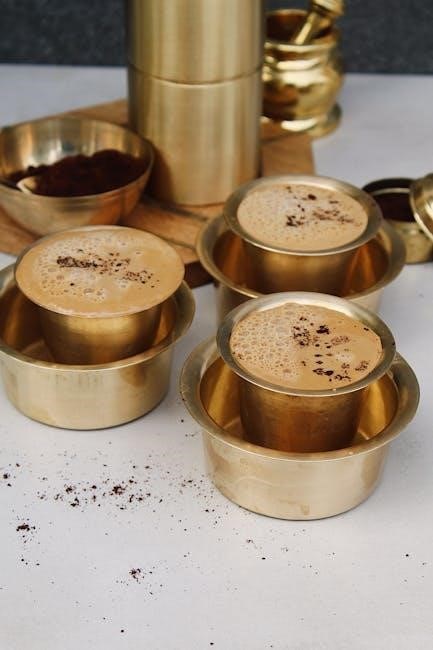South Indian Breakfast Menu: An Overview
South Indian breakfasts offer a vibrant and diverse culinary experience, packed with flavors and textures․ The menu features staples like idli, dosa, uttapam, and pongal, accompanied by flavorful sambar and a variety of chutneys, showcasing the region’s rich gastronomic heritage․
South Indian breakfast is celebrated for its wholesome and flavorful dishes, offering a diverse range of options to kickstart the day․ It’s a symphony of tastes and textures, blending the tanginess of sambar, the freshness of coconut chutney, and the heartiness of dishes like idli and dosa․
This cuisine is not only delicious but also boasts numerous health benefits, supporting immunity, brain function, and overall well-being․ It’s a delightful alternative to bread-based breakfasts, providing a nourishing and light start․ South Indian breakfast recipes often prioritize easily digestible ingredients and balanced nutrition․
With recipes passed down through generations, each dish carries a story, a tradition, and a touch of love․ From the crispy dosas to fluffy idlis, every bite is an exploration of South India’s rich culinary heritage․ It is indeed a perfect way to energize your body and delight your taste buds․

Staple Dishes
South Indian cuisine boasts an array of staple breakfast dishes, each offering a unique flavor and texture․ From fluffy idlis to crispy dosas, these dishes form the foundation of a satisfying and nutritious South Indian morning meal․
Idli: Soft and Fluffy Steamed Cakes
Idli, a quintessential South Indian breakfast item, is celebrated for its soft, fluffy texture and subtle flavor․ These steamed cakes are made from a fermented batter of rice and urad dal, offering a light and easily digestible start to the day․ The fermentation process enhances the nutritional value and imparts a slightly tangy taste․
Typically served with sambar and coconut chutney, idli provides a balanced combination of carbohydrates and proteins․ Its versatility allows for various adaptations, such as rava idli (made with semolina) or kanchipuram idli (spiced with pepper and ginger)․
Idli’s popularity stems from its health benefits, being steamed rather than fried, and its adaptability to different palates․ It is a beloved breakfast choice across South India and beyond, representing a comforting and wholesome culinary tradition․ The simplicity of ingredients belies the complex flavors achieved through the fermentation process․
Dosa: Crispy Crepes Made from Fermented Batter
Dosa, a beloved South Indian breakfast staple, features crispy crepes crafted from a fermented batter of rice and lentils․ The fermentation process lends a subtle tang, enhancing the overall flavor profile․ Spread thinly on a hot griddle and cooked until golden brown, dosas offer a delightful textural contrast․
Served with sambar and chutney, dosa provides a balanced and satisfying meal․ Its versatility allows for numerous variations, including masala dosa (stuffed with a spiced potato filling) and neer dosa (a delicate, lacy crepe)․
Dosa’s widespread appeal stems from its customizable nature and ability to be enjoyed plain or with diverse fillings․ It represents a culinary art form, showcasing the mastery of fermentation and cooking techniques․ The crispy exterior and soft interior create a sensory experience that delights breakfast enthusiasts worldwide․ From traditional to modern adaptations, dosa remains a timeless classic․
Uttapam: Savory Pancakes with Toppings
Uttapam, a delightful South Indian breakfast option, presents savory pancakes crafted from a fermented batter, similar to dosa․ However, uttapam distinguishes itself with its thicker consistency and the incorporation of various toppings․ The batter, made from rice and lentils, undergoes fermentation, lending a subtle tang that enhances the flavor․
Common toppings include onions, tomatoes, green chilies, and coriander, which are pressed into the batter while cooking․ This creates a colorful and flavorful dish that offers a delightful textural contrast․ The savory pancakes are cooked on a griddle until golden brown, ensuring a soft interior and slightly crisp exterior․
Served with sambar and chutney, uttapam provides a balanced and satisfying meal․ Its versatility allows for creative adaptations, incorporating vegetables like carrots, capsicum, and even cheese for a more contemporary twist․ Uttapam’s customizable nature and ease of preparation make it a popular choice․
Pongal: A Rice and Lentil Porridge
Pongal, a comforting and traditional South Indian breakfast dish, is a savory porridge made from rice and lentils․ This wholesome dish is known for its simplicity and nourishing qualities, making it a popular choice for a hearty morning meal․ The two primary variations of pongal are Ven Pongal and Sweet Pongal, each offering a unique flavor profile;
Ven Pongal, the savory version, is typically seasoned with black pepper, cumin, and ghee, lending it a subtle spiciness and rich aroma․ Moong dal is the commonly used lentil, adding a creamy texture to the porridge․ The dish is often garnished with cashews and curry leaves, enhancing its visual appeal․
Sweet Pongal, on the other hand, is a celebratory dish prepared with jaggery, lending it a sweet and caramel-like flavor․ Cardamom and nuts are added for additional aroma and texture․ Pongal is not only delicious but also considered auspicious, often prepared during festivals and special occasions․ Its ease of digestion and nutritional value make it a favored breakfast option․
Vada: Savory Fried Doughnuts
Vada, a quintessential South Indian breakfast item, is a savory, doughnut-shaped fritter that tantalizes taste buds with its crispy exterior and soft, fluffy interior․ Made primarily from urad dal (black lentils), vada offers a delightful combination of textures and flavors․ The lentils are soaked, ground into a batter, and then deep-fried to golden perfection․
Medu Vada, the most popular type, is characterized by its distinctive hole in the center, ensuring even cooking․ Spices such as curry leaves, green chilies, and ginger are often added to the batter, infusing the vada with a fragrant and zesty flavor․ The vada is traditionally served hot, accompanied by sambar and coconut chutney, enhancing its taste profile․
Other variations include Masala Vada, made with chana dal (split chickpeas) and various spices, and Sambar Vada, where the vada is soaked in flavorful sambar․ Vada is a versatile dish enjoyed not only for breakfast but also as a snack or appetizer․ Its satisfying crunch and savory taste make it a beloved element of South Indian cuisine․
Upma: A Semolina-Based Dish
Upma, a comforting and versatile South Indian breakfast dish, is primarily made from semolina (rava or sooji)․ This savory porridge is a staple in many households, prized for its ease of preparation and nutritional value․ The semolina is roasted to a golden hue, enhancing its nutty flavor, before being cooked with water or broth․
A tempering of mustard seeds, urad dal, and curry leaves in oil or ghee forms the base, lending a distinct aroma and taste․ Vegetables such as onions, carrots, peas, and beans are often added, boosting the dish’s nutritional content and adding texture․ Spices like green chilies, ginger, and asafoetida further enhance the flavor profile․
Upma can be customized to suit individual preferences, with variations including vegetable upma, tomato upma, and even curd upma․ It is typically served hot, often accompanied by coconut chutney or lemon wedges, which complement the savory flavors․ Upma is a wholesome and satisfying breakfast option, providing sustained energy throughout the morning․ Its simplicity and adaptability make it a beloved dish across South India․
Accompaniments
South Indian breakfasts are incomplete without flavorful accompaniments․ Sambar, a lentil-based vegetable stew, and a diverse array of chutneys, such as coconut, tomato, and coriander, enhance the main dishes, providing a symphony of tastes and textures․
Sambar: Lentil-Based Vegetable Stew
Sambar is a quintessential South Indian lentil-based vegetable stew, an integral part of breakfast․ It is a flavorful and aromatic dish that complements various breakfast items like idli, dosa, vada, and uttapam․ The stew is prepared with a base of lentils (typically toor dal), tamarind extract for tanginess, and a medley of vegetables․
Common vegetables include okra, eggplant, drumsticks, carrots, and pumpkin․ The sambar is seasoned with a unique blend of spices known as sambar powder, which typically includes coriander seeds, cumin seeds, fenugreek seeds, dried red chilies, and curry leaves․ The spices infuse the stew with warmth and complexity․
The preparation involves cooking the lentils until soft, sautéing the vegetables with spices, and then simmering everything together with tamarind extract․ A tempering of mustard seeds, curry leaves, and dried red chilies in ghee or oil is added at the end to enhance the flavor․ Sambar provides a nutritious and satisfying element to the breakfast, offering protein, fiber, and essential nutrients․
Chutneys: Coconut, Tomato, and Other Varieties
Chutneys are indispensable accompaniments to a South Indian breakfast, adding bursts of flavor and texture that elevate the entire meal․ These vibrant condiments are made from a diverse range of ingredients, offering a delightful spectrum of tastes from sweet and tangy to spicy and savory․ Coconut chutney is a classic favorite, prepared with freshly grated coconut, green chilies, ginger, and tempered with mustard seeds and curry leaves․
Tomato chutney offers a tangy and slightly sweet counterpoint, made with ripe tomatoes, onions, garlic, and a blend of spices․ Other popular varieties include peanut chutney, coriander chutney, and tamarind chutney, each with its unique flavor profile․ These chutneys are typically ground into a smooth or slightly coarse paste, depending on the desired texture․
The versatility of chutneys allows them to be paired with a variety of breakfast dishes, such as idli, dosa, vada, and uttapam․ They can be served as a dipping sauce or spread, adding moisture and enhancing the overall taste of the breakfast․ Chutneys not only provide flavor but also offer nutritional benefits, as they are often made with fresh herbs and spices․

Regional Variations and Specialities
South Indian breakfast cuisine is a vibrant tapestry woven with regional variations and specialties, reflecting the diverse culinary traditions of each state․ In Tamil Nadu, you might find Vendhaya Dosai, a fermented fenugreek dosa, or Kanchipuram Idli, a spiced version of the classic steamed cake․ Kerala boasts Appam, a lacy, fermented rice pancake, often paired with vegetable stew․
Karnataka presents Benne Dosa, a crispy, butter-laden dosa, and Neer Dosa, a thin, delicate crepe․ Andhra Pradesh is known for Pesarattu, a green gram dosa, and Uppu Urundai, steamed rice balls seasoned with spices․ Each region incorporates local ingredients and techniques, resulting in unique breakfast experiences․
Mumbai, though not a South Indian state, has its own adaptations of South Indian breakfast dishes, such as Spring Dosa, Cheese Dosa, and Mysore Masala Dosa․ These regional variations add depth and complexity to the South Indian breakfast landscape, inviting exploration and culinary adventure․ Whether it’s a simple dosa or an elaborate Pongal, each dish tells a story of its origin․

Health Benefits of South Indian Breakfast
South Indian breakfast options are often celebrated for their nutritional advantages, offering a wholesome start to the day․ Many dishes, such as idli and dosa, are steamed or lightly cooked, preserving essential nutrients and minimizing the addition of unhealthy fats․ Fermented foods like idli and dosa promote gut health through probiotics, aiding digestion and boosting immunity․
Ingredients like lentils and rice provide a balanced combination of carbohydrates and proteins, offering sustained energy throughout the morning․ Sambar, a lentil-based vegetable stew, adds fiber, vitamins, and minerals to the meal, contributing to overall well-being․ Dishes like upma can be made healthier by using whole wheat flour, adding more fiber and nutrients․
The use of spices like turmeric, ginger, and cumin in South Indian breakfast preparations further enhances their health benefits, offering anti-inflammatory and antioxidant properties․ By incorporating a variety of vegetables and legumes, South Indian breakfast meals support immunity, brain function, and overall health․ Choosing traditional South Indian breakfasts over processed options can contribute to a more balanced and nutritious diet․

Tips for Preparing South Indian Breakfast
Preparing a delicious and authentic South Indian breakfast requires attention to detail and a few helpful tips․ Start by sourcing high-quality ingredients like parboiled rice and urad dal for idli batter to achieve the perfect soft and fluffy texture․ Soaking the rice and lentils for the appropriate duration, usually around 4-6 hours or overnight, is crucial for proper fermentation․
Grinding the batter to the right consistency is essential; it should be smooth but not too runny․ Allowing the batter to ferment in a warm place for 8-12 hours is key to achieving the characteristic tangy flavor and light texture of idli and dosa․ When making dosa, ensure the tawa (griddle) is properly heated and lightly oiled to get a crispy, golden-brown crepe․
For upma, roast the semolina until it turns slightly golden to enhance its flavor and prevent it from becoming sticky․ When preparing sambar, use fresh vegetables and a good quality sambar powder for an authentic taste․ Experiment with different chutneys like coconut, tomato, or coriander to complement your breakfast dishes․ Don’t be afraid to adjust spice levels to suit your preference, and always serve your South Indian breakfast hot for the best experience․
